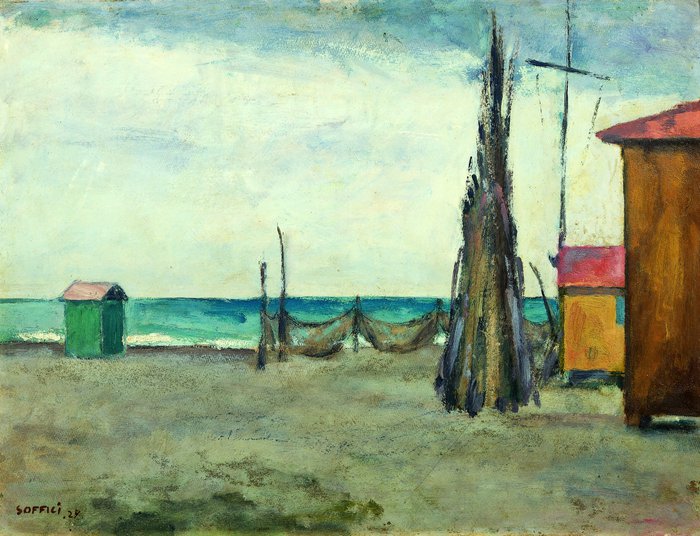Information about the artwork
- Artist/maker
- Ardengo Soffici
- Title
- Cabins
- Date
- 1927
- Materials and Techniques
- 17
- Dimensions
62 x 47 cm
- Location
-
Palazzo Pretorio Museum
Third Floor
Our site saves small pieces of text information (cookies) on your device in order to deliver better content and for statistical purposes. You can disable the usage of cookies by changing the settings of your browser. By browsing our website without changing the browser settings you grant us permission to store that information on your device. I agree
62 x 47 cm

Beach Cabins is one of the two works by Ardengo Soffici displayed in the section on Soffici and the School of Prato. It was painted in Forte dei Marmi in 1927 and is the expression of the “return to order” after the formal experiments of the historical avant-garde movements. The aim of his “return” was to recover the Tuscan tradition and the real quality of art. In its harmonious tonal composition recalling old frescoes, in the simple rendering of nature, in the “pure painting”, this picture has poetic affinities with the contemporary works of his friend Carrà.
After the Great War many artists in various countries abandoned the formal experiments of the historical avant-garde (from Futurism to Expressionism, to Cubism) to attempt a refoundation of art along different paths. Some, like Carrà, Derain or Soffici himself, aimed at the recovery of archaic traditions and the real quality of art. This “return to order”, which has been interpreted negatively as a closure, a choice of self-isolation in time and space, actually aimed at a “return to craftsmanship”, to the values of an art which has a true quality, as expressed in a well-known article by De Chirico in 1919. For Soffici, the quality of the paint texture was a constant from the early 20th century up to his death. He willingly accepted the risk that his choice, the works produced in his voluntary exile in Poggio a Caiano, would be seen as a cowardly return to provincialism similar to that of the “strapaese” post-war literary movement. As he writes to Carrà: “I don’t admit anything but simplicity in the face of the nature I wish to study deeply and render with honesty, rejecting all theories and any kind of pseudo-intellectual preconception”. Cabins gives a good example of the artist’s poetic intent, in its loose brushwork, harmonious tonal composition recalling old frescoes, and “pure painting”. A 1926 notebook contains the drawings made by Soffici on the Versilia beach of Forte di Marmi, where he painted with Carrà every year up to his last years.
In Palazzo Pretorio, Soffici’s painting The Veteran is also exhibited.
It would be interesting to visit also the SofficiMuseum in Poggio a Caiano, where the artist spent the most of his life.